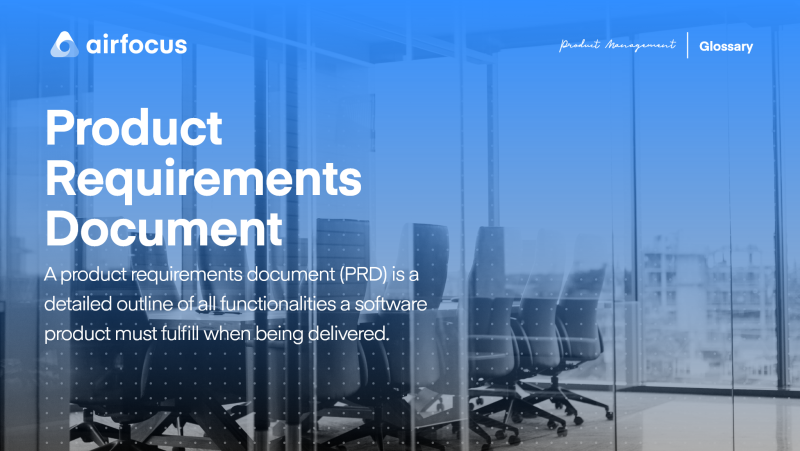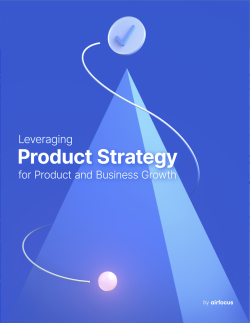Product Requirements Document
What is a Product Requirements Document?
Definition: A product requirements document (PRD) is a detailed outline of all functionalities a software product must fulfill when being delivered.
The PRD describes the magnitude of a product and serves as a record of all features that must be realized or in retrospect, must be found in the product.
Each functionality is characterized as an individual use case and needs to explain its purpose to establish an accurate understanding for a cross-functional team to take measures during the implementation process.
Additional conditions such as environmental requirements, e.g. hard- and software utilization of the end-user, constraints, and dependencies also need to be specified in the product requirements document.
What should a product requirements document contain?
What should a product requirements document contain?
Each element of a product requirements document (PRD) provides clear direction, fostering team alignment and collaboration. Here’s what you should include in a PRD:
Executive summary: A brief overview of the product, including its objectives and strategic goals.
Key metrics for success: Measurable objectives that track progress and determine the product’s success.
Problem alignment: A clear statement defining the problem the product aims to address. This helps stakeholders understand its relevance and helps the development team understand why they are building the product.
Solution alignment: A description of how the product solves the stated problem.
Key features: A prioritized list of core features detailing their importance and functionality.
Milestones/roadmap: An outline of significant development milestones and deliverables to share with stakeholders and team members.
Launch plan: Steps and strategies necessary to achieve a successful product launch.
Stakeholders: A list of key stakeholders and their specific roles in the project.
Assumptions and constraints: Any assumptions or limitations impacting the project.
Risks and mitigations: Potential risks and strategies that could address or minimize them.
Appendices: Additional supporting information, like research, technical details, or references.
Your PRD should take a top-down perspective, beginning with a broad vision of the goals you wish to achieve. It should then link product objectives and efforts to the features needed to realize that vision. A proper PRD also provides information about what the user will see — and how — while interacting with the feature.
The golden rule is for PRDs to be clear and concise.
What are the steps in creating a PRD? (and how to start writing)
Writing a product requirements document might come down to just one person, but multiple people or stakeholders will be involved in the thinking behind what’s written.
Below, we’ve listed the five steps in creating a PRD.
1. Establish the product’s purpose
The product and development team has to be aligned, sharing the same objectives of the product vision. This purpose must be the driving factor for the features and should outline the problems solved by the product, the target audience, and why exactly is it important to solve those problems for them.
2. Put forward the must-have features
What are the release feature requirements? Remember that if a feature doesn’t help achieve the product’s purpose, then it shouldn’t make the list.
Defining initiatives and themes is a common practice when it comes to setting the feature requirements. A good theme can align a company for years. Examples of themes would be harnessing IoT technology to improve user experience or helping amateur photographers access professional-grade tools.
3. Set your release criteria goals
In order to achieve the objective of the product, you need to set the right goals. The goals of the product should make it actionable, easy to understand, achievable and measurable. The release criteria, in particular, has five areas it needs to cover: usability, functionality, reliability, supportability and performance.
4. Agree to a timeline
You don’t need to set an exact date, but every product release has to have at least a rough estimate of when you’ll go to market. Keeping it rough will allow for pivots or unforeseen issues.
5. Review your PRD as a team
When you finish your PRD, you need to have the stakeholders review it. Be flexible to any changes they might ask of you, as the only way a product requirements document works is when it has full team buy-in.
How to create a product requirements document easily
To create a product requirements document, you need to create a section for each of the items listed above. But starting from scratch can take lots of time and effort. That’s why opting for a ready-made product requirements document template can make the process easier and more efficient.
airfocus’ product requirements document template offers a comprehensive yet simple starting point, allowing product managers to create effective PRDs without the hassle. This fully customizable template can be tailored to fit any project or work style, making it a great tool for agile or waterfall teams.
This template helps teams:
Clarify product goals, features, and milestones.
Keep stakeholders informed and aligned.
Provide a more structured approach to product development.
Key features of the airfocus PRD template include:
A comprehensive structure covering all essential elements of the PRD.
Customizable sections you can adapt to your product.
Clear metrics to help you define success and track progress.
Integrations with the product management tools you already use.
Try out the airfocus product requirements template for free today.
What’s the difference between a PRD and an MRD?
It’s easy to get PRDs and MRDs confused — especially when just the initialism is used. Once you see the full name, the differences become much clearer:
PRD = product requirements document
MRD = market requirements document
As covered above, the PRD outlines how the product should be produced, while an MRD defines what customers require and how the product will meet those needs.
You can think of the PRD as a roadmap for engineering and design teams, as well as other large cross-functional teams, in order to grasp what the product needs to deliver to add value.
The MRD should be written first, and then the PRD. After all, you need to have explored the market opportunity before deciding to build a product.
Because of this, the MRD is often created by product managers during the early phases of a brand-new product launch — perhaps in Product Discovery. But it’s not a ‘once and done’ process. Changing market trends and growing consumer demands always bring new product options, so it’s a good idea to review the MRD on a regular basis, even after the PRD is complete.
Both MRDs and PRDs need to be open to change.
> Here is an example template of a product requirements document from Atlassian.
Why use a PRD?
The product requirements document exists as a single source of truth that aligns all relevant parties with the product’s purpose, target audience, key features, development timeline, and acceptance criteria. Its main benefit is to ensure everyone is clear on key parts of the development process, including dependencies, potential roadblocks, risks, and assumptions before development gets underway. Once development starts, the PRD is used to keep the project on course and in line with expectations.
Since the PRD defines product goals, it helps prevent scope creep. Anything not included in the product requirement document can be tabled for another time, ensuring the project continues without distraction.
Product requirements documents help build better team relationships by looping in everyone who needs to be involved in the project. PRDs help to manage expectations and introduce a level of accountability by outlining who is responsible for what. This means everyone can keep track of each task, who they’re assigned to, and when they’ll be completed.
Who uses a PRD?
Everyone involved in a product’s development will use the product requirements document, though different roles will have different responsibilities.
The PRD is typically created by the product manager, product owner, or cross-functional teams during the planning stages of development. They will ensure the document contains all the relevant requirements for the product, including timeframes and success criteria.
Throughout development, the PRD is used to communicate with stakeholders, team members, and other teams within the business. This helps guide development, ensures the product aligns with overall business goals even as requirements change, and guides product backlog management.
How PRDs fit into Agile and Lean methodologies
As a living document, the product requirements document is perfect for Agile and Lean teams. You can update the PRD at any point in the development process to reflect new information and use it to update the team and stakeholders on new requirements.
You can make your PRD lean by slimming down the document to focus on validating assumptions and learning as much as possible about the user before development gets underway. For a lean PRD, include user stories, personas, value propositions, hypotheses, key metrics, stakeholder feedback, and a timeline. It should also include a clear scope for the MVP to help teams prioritize features and manage the product backlog.
Keep Agile or Lean product requirements documents to one page long. While traditional PRDs can be longer, the Agile PRD needs to be as concise as possible with enough specifics to guide development. Don’t worry about cramming every possible feature into the Lean PRD — you’ll update the document throughout development to keep the focus on the right activities at the right times.

General FAQ

Glossary categories
Create effective product strategy

Experience the new way of doing product management








